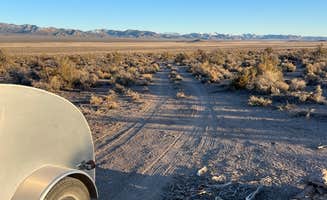Dispersed camping opportunities near Alamo, Nevada consist primarily of undeveloped sites on public lands managed by the Bureau of Land Management. Located in Lincoln County at an elevation of approximately 3,450 feet, this high desert region experiences extreme temperature variations with summer highs regularly exceeding 100°F and winter nights often dropping below freezing. Access to most primitive camping near Alamo, Nevada requires traveling unpaved roads that vary in condition depending on recent weather events.
What to do
Explore nude recreation areas: At Outcrop Rock, visitors can enjoy clothing-optional hiking around the distinctive rock formations. One camper noted, "I spent a couple of days here in August and did some nude hiking around the rock areas. I had the whole place to myself for most of the time."
Joshua tree viewing: The backcountry roads around Alamo provide opportunities to see native Joshua trees in their natural habitat. A visitor to Dispersed Camping - Mormon Well Road/Desert Pass reported, "Saw a Bunch of Beautiful Joshua trees!"
Stargazing: The remote location and minimal light pollution make Alamo's dispersed camping areas excellent for nighttime astronomy. The clear desert air and distance from major cities create optimal conditions for viewing celestial objects throughout the year.
What campers like
Quick highway access: Some dispersed sites offer convenient accessibility despite feeling remote. A camper at Outcrop Rock shared, "Fun little spot for the night right off the 93. BLM land. You can see two distinct rock croppings off the highway. Turn down a dirt road and then right on the first turn off."
Solitude and privacy: The remote nature of these sites provides isolation from other campers. As one visitor noted, "I had the whole place to myself for most of the time."
Good cell coverage: Despite the remote location, some sites maintain usable cellular service. A camper reported, "I had good Verizon cell service. You don't really hear the noise from the highway."
What you should know
Extreme temperatures: The desert climate around Alamo creates challenging conditions during summer months. A camper at Dispersed Camping - Mormon Well Road/Desert Pass warned, "The low review is just for how hot and buggy this place was, but that's our own fault for summer camping in the high desert."
Road conditions: Access to primitive camping near Alamo requires driving on unpaved roads. Visitors should check current road conditions before attempting to reach more remote sites, especially after rain or snow events.
Safety concerns: Some dispersed camping locations near Alamo have reported issues with trash and questionable conditions. A visitor to Horneys Rest Stop BLM - Dispersed Site cautioned, "Pulled in and every space was open. But the vibe was sketchy. Toilet paper and trash everywhere. Close to the road and minimal privacy."
Tips for camping with families
Spring and fall timing: Schedule family camping trips during moderate seasons to avoid extreme temperatures. One camper suggested, "Definitely not a summer spot, we will have to give it another try in cooler months."
Bring extra water: The arid desert environment requires more hydration than many visitors anticipate. Each person should plan for at least one gallon of water per day, with additional reserves for emergencies and cleaning.
Insect protection: Prepare for seasonal insect activity, particularly during warmer months. A visitor mentioned the area was "hot and buggy," indicating the need for appropriate insect repellent and protective clothing.
Tips from RVers
Site selection considerations: For RV camping at Upper Lake Road BLM Campsite, select level spots away from dry washes that could flood during rain events. The terrain includes both soft sand and rocky areas, requiring careful positioning to avoid getting stuck.
Length restrictions: Most primitive camping areas near Alamo have limited turnaround space and narrow access roads that may not accommodate larger rigs. Vehicles over 25 feet in length should research specific site dimensions before attempting access.
Self-contained requirements: With no facilities available at dispersed sites, RVers must be fully self-contained with adequate water storage, waste capacity, and power generation for their intended stay duration.


